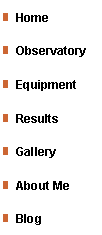

|
Blog |
|
ARCADIA ASTRONOMICAL OBSERVATORY |
|
To contact us: | E-mail: andras@arcadiaobservatory.org
|
|
11 May 2020
There is seemingly no end of disasters this year. First the unprecedented Australian fires followed by massive storms and floods. In mid march the unprecedented COVID-19 virus pandemic struck. It stopped almost everything globally and everyone is in lockdown. Luckily it has not affected the core business of this observatory of planetary defence coordinated by NASA with the main survey observatories continuing to track down that last 10% of NEOs and PHAs (Potentially Hazardous Asteroid).
For Arcadia Observatory, March was a meagre month due almost continuos bad whether and the lack of targets to follow up. New NEOs on offer on the NEOCP site appear to be getting if not fewer then fainter, with most of them moving to the limits of observability of smaller telescopes used by amateurs such as Arcadia Observatory. Must be getting near the bottom of the barrel for NEOs that need to be reported. Despite this Arcadia Observatory managed to confirm 12 new NEOs resulting in MPECs for the month of April.
17 February 2020
The fires are out now thanks to the massive monsoon style downpour for the three days of 7, 8 and 9 of this month (February) finishing on the Sunday with a storm that flattened three or four large trees on this property and caused widespread blackouts all over Sydney. We were on generator and without a telephone landline for 5 days. The observatory escaped with a bit of water spray entering due to the horizontal rain during the storm. Luckily the equipment was covered with plastic sheets. Not so lucky was the observatory computer which refused to boot following the storm event on the Monday. Not sure why, it didn’t get wet. There was a backup computer which however was not loaded with the observatory software and the old machine wasn’t backed up. I spent 2 or 3 days installing the mostly 10 year old software from original sources. It turns out the new (old backup running XP) computer isn’t quite up to running all necessary software simultaneously but it will have to do for the moment until I find a better one running Windows XP.
So for all the above reasons including almost no clear skies this month I have not posted any observations to MPC this month so far.
10 January 2020
There was very little observing done since the middle of December. Firstly because Sydney has been surrounded by bush fires on an unprecedented scale which filled the air and the sky with thick and very unhealthy smoke. One burnt area to the north west includes most of the Wollemi National Park and a big chunk of the Blue Mountains National Park, about 5000 square kilometres, the other to the south west includes more of the Blue Mountains National Park and stretches all the way south to the Southern Highlands, about 2700 square kilometres. In addition a large proportion of coastal NSW is also burnt. The fires are still burning and will burn until significant rain falls. Apart from the health hazard the smoke reduces and sometimes totally blocks out the sky, day and nights for astronomical observations. Secondly, at this time of the year the ecliptic is very low in the night sky. NEO candidates like most solar system bodies are normally found within a few degrees of the ecliptic. So the total score for December was only 2 MPECs for NEOs and the observation of Comet C/1019 Y1 for which no MPEC was issued.
The year finished with the total of 84 MPECs featuring Arcadia Observatory.
8 November 2019
With the completion of the dome automation project, astronomical activity has settled back into the routine NEO (Near Earth Object) follow up reporting and asteroid sky survey activity. The nightly routine is: If the sky is clear (or clear enough) check the MPC NEOCP page for accessible new NEO candidates for follow up observations. By accessible I mean the object, in addition to being south of 25 degrees north declination, it must be brighter then 20V magnitude and move slower then 60 arc sec per minute. These are absolute limits for the C14 telescope. If there are no suitable candidates or there is a spare 1 or 2 hours before or after observing NEO candidates, a survey run looking for new asteroids is also planned. Survey runs are only done on moonless nights. A one hour survey run observes ten 1.5 by 1.1 degrees areas of the sky 3 times. That is, in an hour a total of 17 square degrees of the sky is examined to the depth of about 18.5V magnitudes for anything that moves that cannot be attributed to an existing asteroid. Any suspects are checked by Astrometrica against the MPC’s MPCORB database containing all known, some 650,000, asteroids and their current positions. Anything not identified with a known object is a potential new discovery. Sadly, none has been found so far. Score of MPECs for successful follow up observations of new NEO candidates for: August: 8 September: 3 October 8:
18 August 2019
Continuing to refine the observatory dome control software. After fixing the occasional noise pulse issue from the dome position encoder sensors by properly measuring the pulse widths and throwing away the very short ones, one last problem remained. When the dome was driven very slowly as when tracking the sky, the friction drive wheel would start slipping at one or two points of higher resistance along the track. The problem was solved in the software by firstly detecting the slippage i.e. no movement when the motor is turning, and reversing from the point of resistance then driving the dome at high speed forward past the point of resistance. It’s a bit messy but appears to work in all cases so far. The current version of the Arduino software can be found here.
8 July 2019
After deciding not to submit my observations of 26 June of the light curve of NEO/PHA (Potentially Hazardous Asteroid) 66391 (1999 KW4) I checked how much data was already available on its light curve and rotational period in the ALCDEF database. The Asteroid Lightcurve Data Exchange Format (ALCDEF) is the database of lightcurve data where amateur (and professional) astronomers are encouraged to send their observations. It was created by Brian Warner and hosted by the Minor Planet Center (MPC). It only showed two previous observations so I decided that it may be worth submitting my 310 datapoint light curve despite being somewhat ‘noisy’. This was my first submission of asteroid photometry to ALCDEF. In addition to submitting the raw data to ACLDEF, I also processed the data using Brian Warner’s MPO Canopus application to determine the rotational period of this binary asteroid.
|
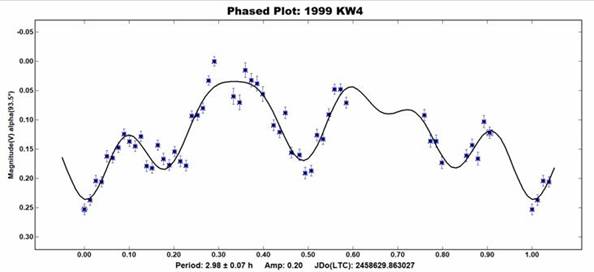
|
11 October 2020
The COVID-19 virus I still out there but under control in NSW and life is almost back to normal. El Ninna is here and the drought is nearly gone. Routine NEO follow up activity continues without interruption but the offerings on the NEOCP appear to be decreasing month by month. MPECs achieved since April: May 2, June 2, July 6, August 5, September 10.
Another very favourable appearance of Mars is here, not to return for decades so I took the opportunity to have another go for some ‘pretty pictures’. I have converted the C14 back to its original SCT configuration for its long focus (3900mm) needed for planetary photography. Here is the best I could do with my ZWO120 camera I purchased 2 years ago for the last appearance of Mars which was wiped out by the global sandstorm. This image was processed from a clip of 8000 frames at 200fps by AutoStakkert! 2.6.8 and Registax 6 showing area centred on Aurorae Sinus at meridian 45.
|
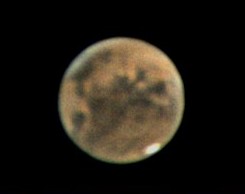
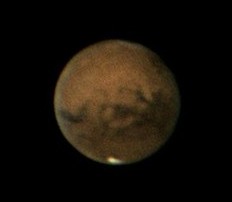
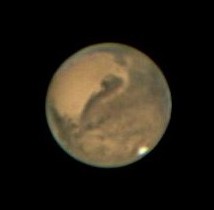
|
15 November 2020
Spent all of October doing planetary photography using the C14 in SCT mode making use of its 3910mm focus and the ZWO120 camera at prime focus. Here is a selection of the best of the three planets available in October. I said good bye to Mars at the end of the month and restored the telescope to HyperStar mode at f/1.9 for NEO and survey work. Mars won’t be this close for 35 years. |
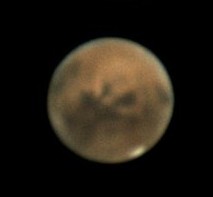
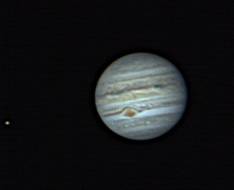
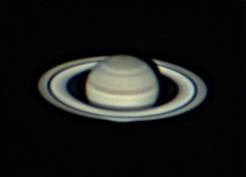
|
|